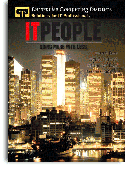CIO Wisdom – Table of Contents
CIO Wisdom
Best Practices from Silicon Valley’s Leading IT Experts
First edition; 412 pages
ISBN 0-13-141115-2
( by: Dean Lane)
Table of Contents
Chapter 1
Within and Beyond: Understanding the Role of the CIO
By Al Pappas & Stuart Robbins
- Perspective 1: The Extended Enterprise CIO
- Perspective 2: Back to the Basics- What is a CIO?
- Overview of the CIO Role
- Background of the CIO- Technology Vs. Business
- Business Environments and the CIO’s Role
- Reporting Relationships, Hierarchy, and the CIO’s Role
- Understanding the Dynamic Role of the CIO
Chapter 2
Women CIO’s
By Judy Armstrong
- Why Single Out a Particular Group of CIO’s
- Why Is IT Unfriendly to Women?
- What is IT Losing When Women Leave the IT Workforce?
- What Do We Need to Change to Attract More Women into the IT Profession?
- Why Do Some Women Prevail and Others Do Not?
- What Is Different for Women CIO’s in Their First 90 Days?
- Who Are Some of the Successful Women CIO’s and Why?
- Pat Anderson, CIO of Lockheed Martin’s Space Systems
- Polly Moore, Former CIO of Genentech
- Tama Olver, CIO of Applelera
- The Value of Women in IT
Chapter 3
The First 90 Days
By Mark Egan
- Key Takeaways
- Overview
- Ninety-Day Tactical Plan
- IT Organization Review
- IT Strategic Plan
- Step 1
- Step 2
- Step3
- Step 4
- Step 5
- IT Architecture Blueprint
- Architecture Overview
- Management Recommendations
- Pulling It All Together
Chapter 4
The Tao Perspective
By George Lin
- An Indirect but Fundamental Approach
- CIO Challenges
- Creating a Business-Focused IT Organization
- Leading by Example: Five Fundamentals for Better IT/Business Alignment
- Uniting the Forces: Five Strategies to Align the Business
- Sustaining Success: Two Practices
- In Closing
Chapter 5
Communications: Communication Excellence in IT Management
By Brenda J. Fox
- The Problem: Us Vs. Them
- How to Break Down Stereotypes that Threaten Good Communication
- Lead by Example
- Know Your Audience
- Create Awareness of the Lines of Communication
- Start Thinking Like a Service Organization
- Ask Your Staff for Help
- Stop the Blame Game
- Provide Accurate Information
- Foster Teamwork
- Essential Management Practices that Produce Good Communication
- Plan
- Set IT Policy and Standards
- Understand the Company’s Commitments, Schedules, and Dependencies
- Integrate Project Planning
- Budget as a Team
- Control Production Changes
- Continuously Improve Quality
- Be Explicit in Your Decision-Making Process
- What to Keep in Mind when Implementing Communication Tools and Practices
- Deliver Information that Each Group Requires
- Communication Tools Depend on Accurate Process-Level Information
- IT is a Team Support
- Tools Must Measure Project Status at All Levels
- How to Make Yourself a Better Communicator
- Assess Yourself
- Know Your Audience
- Set and Manage Expectations
- Insist on Accountability
- Be Aware of the Political Environment
- How to Know When Communication Is Good
- Measure Behavioral Improvements
- Process Improvements
- Improvements in IT Business Fundamentals
- Conclusion
Chapter 6
IT Organization
By Guy de Meester
- Challenges in Determining the Ideal IT Organization
- Follows the Business Plan
- Be the Driver or Be Driven
- Centralized Vs. Decentralized Organizational Structure
- Helpdesk and Desktop Support
- Network and System Administrator Functions
- Telecomm Support Functions
- Applications Support Functions
- Reflections on Critical Information Systems Functions
- Operations Director
- Architect Function
- Database Administrator Function
- Desktop, Helpdesk, and System Administration Support
- Project Management
- Decisions and Topics Impacting the Organizational Model
- Policies and Procedures: Impact on the Organization
- Roles and Cooperation of functional Departments
- Effect of Budget Type on Organizational Model
- Remote Management and Its Implications
- Business Drivers: Impact on the Organization
- Internet Support and Implications
- Insourcing or Outsourcing: Impact on the Organization
- Metrics and Management
- Mergers and Acquisitions: Impact on the Organization
- The IT Organization in Down Times
- Final Comments on IT Organizations
Chapter 7
Governance
By Danny Maco
- The Paradox of IT
- The Role of the New CIO
- What is Governance?
- Successful Governance
- Skills to Help You Govern
- Typical Governing Bodies
- Considerations Related to Governing Bodies
- Operational Governance
- Creating a Governance Model for Your Organization
- Putting a Governance Model in Place
- Managing Expectations for Governance
- How Much Energy should Be Committed to Governance?
- Evolution of Governance
- Mistaken Uses of Governance
- Effect of Acquisitions on Governance
- Summary
Chapter 8
Architecture
By John Dick, Holly Simmons, Maureen Vavra, and Steve Zoppi
- Are We Having Fun Yet?
- Overview
- The Classic Architecture Approach
- Enterprise Architecture Overview
- Planning for an Enterprise Architecture
- Aligning IT with the Business
- Budgeting for an Enterprise Architecture
- Structuring an Organization to Support Your Enterprise Architecture
- Architectural Review and Fit Assessments for Systems, Technology, Major Changes
- Change Management at the Meta and Operational Level: A Critical Success Factor
- Component Architecture
- Overview of the Functional Roadmap
- Drilling Down in the Functional Roadmap
- Multi-tier Architecture, Layer by Layer
- The Network Access Layer
- The Distributed Data Access Layer
- The Applications and Database Layers
- The Inter-Enterprise Integration Layer
- Developing Strategic IT Portfolio
Chapter 9
Strategic Outsourcing
By Bharat C. Poria
- Understanding Outsourcing
- Elements of Outsourcing
- Options for Outsourcing
- Onsite Support
- Offsite and Offshore
- Offsite and Onshore
- Functional Support
- Program or Project Support
- Conclusion: Trends and Opportunities
Chapter 10
IT Workforce
By Dean Lane
- Five Basics for Retaining IT Professionals
- Training
- Communication
- Leadership
- Environment
- Motivation
- A Can-Do Attitude Cannot Be Beat
- Conclusions
Chapter 11
Strategic Planning
By Maureen Vavra and Dean Lane
- Chapter Profile
- The CIO’s Planning Role within the Business
- Business Strategizing
- Follow the Corporate Strategic Plan?
- How CIO’s Influence Strategy
- Systems Planning and the Business
- Departmental IT Models
- IT Plans in a Technology-Oriented Company
- Approaches to Setting Strategic Goals and Objectives
- Traditional Models
- Situational Analysis: The SWOT Model
- Critical Success Factors
- Value Chain Analysis
- Scenario Analysis and Impact Assessment
- IT Planning
- Importance and Value
- Plans Your IT Organization Must Have
- IT Planning Checklist
- Steps to an IT Plan
- Plan to Plan
- Critical Soft Components
- Drivers for Change
- Migration
- Managing to Plan an Outgoing/Evergreen Planning
- Milestones for Applications Portfolio Planning and Project Management
- Setting Priorities
- Putting Things in Context
- Good Staff Work
- Rough Order of Magnitude (ROM)
- High-Medium-Low and Variations
- Rack and Stack
- The Big Picture and Feedback Loop
Chapter 12
IT Infrastructure Management and Execution
By Joe Feliu
- The Operational Framework
- Focus Areas in Operations
- Asset Management
- Capacity Planning
- Change Management
- Disaster Recovery Planning
- High Availability
- Problem Management
- Security Management
- Service-Level Agreements
- Focus Areas in Development
- Programming Practices
- Project Management Process
- Systems Development Lifecycle
- Focus Areas in Human Resources
- Company New Employee Orientation
- Managing Staff Performance
- Training and Staff Development
- A Closing Comment
Chapter 13
Budgeting
By Bob Denis, Maureen Vavra, and John Dick
- Building Blocks for a Strong Budget
- Relationships and Budgets
- Budget Feeds: Significant Influencing Factors to Consider
- Partitioning Your budget
- Capital Expenditures
- Strategic Vs. Sustaining Capital Expenditures
- Expenses
- Headcount Budget
- Ratios and Operating Metrics
- IT Spending as a Function of Revenues
- Other Useful Ratios and Metrics to Consider
- A Simplified Budget Generation Process
- Managing the Budget
- The Budgeting Toolkit
- IT Expense Distribution
- Conclusions
Chapter 14
Marketing the Value of Information Technology
By Judy Armstrong and Steve Zoppi
- Chapter Overview
- The Importance of IT (to Everyone)
- The Plan
- PEST and SWOT (Conceptual Overview)
- Plan Outline
- Assessing the Value Chain
- Operational Excellence: how Will They Know You Are Excellent?
- Walking the Talk
- Making It Your Policy
- Success Stories in Effective Communication
- Customer ecCentricity?
- Highlighting the Basics
- Marketing Advocate: The Credible Individual
- People
- Process
- Technology
- The Right Person for the Job
- Borrowing From Established Best Practices
- Marketing Consistency
- More Marketing Vehicles
- Conclusion
Chapter 15
The Metrics of IT: Management by Measurement
By Shel Waggener and Steve Zoppi
- CFO- Credible Financial Obfuscation
- CEO- Cross Examining Opportunity
- Back to Basics- Breaking the Cycle
- Management by Measurement- Keep It Simple
- Quality Over Quantity- Always
- The Wheel Already Exists
- Money Metrics- You Are What You Eat
- Automate IT
- The balanced Scorecard
- Service-Level Agreements
- Some Final and Initial) Thoughts
Chapter 16
Ladder of Business Intelligence: A Systematic Approach to Success for Information Technology
By James E. Cates
- Business Intelligence
- The Ladder of Business Intelligence
- Defining the Stages of the LOBI
- Value in Moving Up the LOBI
- The LOBI Business Odyssey
- Using The LOBI Model
- Meaning of the LOBI Rating
- Using the BRIA Methodology
- Productivity and LOBI Rating
- An Example Using the LOBI Model
- Approach Using the LOBI Framework
- Summary
Chapter 17
Communities of Practice: Continuing the Learning
By John Moran and Lee Weimer, Community of Practice Facilitators
- Overview of the CoP
- The Silicon Valley CIO Community of Practice (CIOCoP)
- Finding a CoP
Index

















